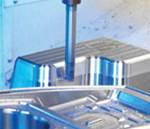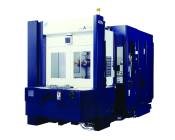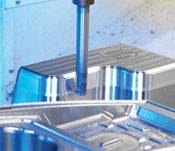Technology Partner Is Key to Expanding Moldmaker Capabilities
The past decade has seen significant shifts at R&D Tool, but with a key supplier by its side, they are equipped for new challenges.
R&D Tool and Engineering has been busy since opening its doors in 1976. The company began as a traditional small shop, manufacturing custom parts for local companies. In the 1980s, R&D expanded its capabilities and set its eyes on the packaging industry. Today, R&D is recognized as one of the world’s leading suppliers of tooling for the global packaging market, offering a wide range of products and design solutions to the packaging, food and beverage, cosmetics, and household and personal care markets. It has manufacturing plants in the United States and the United Kingdom and has sales agents in Mexico, Hungary, Turkey and Russia.
R&D’s evolution didn’t happen overnight. Its capabilities, customers, technology and business needs have changed over the years. In fact, the company continues to evolve today as it adapts its technologies and capabilities to meet the ever-changing demands of the manufacturing market.
“When the shop first opened, we built tools from our customers’ designs,” says Dean Rohr, vice president of manufacturing at R&D. “Shortly thereafter, we realized the need for engineering, so we built our engineering services capability. Now we have the capability to design the mold, sample it and supply the finished product. We also have research and development capabilities, so we can come up with new tooling products.”
Two Significant Changes
Over the past decade, there have been several changes in the manufacturing industry, but Rohr explains the two significant shifts at R&D.
“The two factors that have impacted our company the most are automation and the need for faster cycle times,” says Rohr. “You have to automate to reduce labor costs and you have to decrease cycle times to keep up with the competition.”
R&D has successfully done both. The company uses robots to run machines 24/7 and factors automation into every technology purchase.
“We won’t even consider a machine unless it’s palletized,” continues Rohr.
Rohr feels that in addition to increasing outputs, automation has also been a large cultural change at R&D. The staff was hesitant when the first robot joined the ranks, but they soon realized the company’s automation advances weren’t meant to replace jobs performed by humans.
“Our employees understand that we aren’t replacing them, but they also understand that we’re not going to grow R&D by hiring more staff,” explains Rohr. “Automation creates the need for programmers, and we’ve trained our employees to take on these responsibilities.”
As far as cycle times are concerned, Rohr cites the company’s focus on technology as the reason it has reduced cycle times by almost 50 percent compared to 10 years ago.
“Today, most jobs are out the door in less than 30 days,” says Rohr. “The average delivery on full-production tools is about eight weeks. We’ve been implementing several lean manufacturing principles over the past 12 months and hope to further reduce cycle times by another 50 percent in the coming years.”
Market Influences
While many manufacturing companies point to foreign competition as key drivers of change in the industry, Rohr thinks the largest reason for changes in the North American plastics industry is the United States’ love of disposable products.
“We throw a lot of products away; it’s a disposable market,” says Rohr. “Water bottles are a perfect example. Did you think 10 or 15 years ago that you’d be buying water in plastic bottles? The water bottle craze alone has created a huge volume of work for shops like ours, not to mention everything else that’s similar.”
Rohr admits that competition from China hasn’t gone unnoticed. He believes it has impacted pricing in North America, but he is also comfortable with R&D’s position.
“Being first to market is extremely valuable to our customers,” explains Rohr. “That’s one of the reasons we’ve been able to compete so well. It goes back to faster cycle times, quicker deliveries. We work with our customers to get their products on the shelves first. They can’t get that in China.”
Valuable Partner Is Key
R&D Tool has seen a lot of change in their industry, but one of the constants has been its relationship with Makino.
“We purchased our first Makino machine tool—a vertical machining center—almost 25 years ago,” explains Rohr. “We purchased that machine because of its versatility. Makino has been a valuable partner ever since. It’s the service and dependability of the equipment that keep us coming back.”
As R&D’s capabilities expanded, so did their relationship with Makino. Over time, R&D became more interested in technology. They understood that technology was the key to growing their capabilities and customer base. Today, the company has several Makino machine tools on the shop floor, including conventional EDMs, vertical machining centers and horizontal machining centers. They currently own V55s, A55s, SNC64s, and an A88 with an eight-pallet carousel. Rohr feels his relationship with Makino has evolved with his company’s needs.
“As we took on different work, we looked to Makino to provide us with recommendations on the best tool for the part or capability we were adding,” says Rohr. “They’ve done a great job guiding us to the right technology, all the way up to our recent purchases related to the robot—two EDMs and a graphite mill setup.
“We look to Makino to provide recommendations on every purchase we consider. That doesn’t mean we don’t shop around. We ask the same thing from everyone, but Makino is fundamentally sound in their quoting and feedback process.
“We love figuring out tooling challenges. It’s the toolmaker’s mentality. We have used Makino as a sounding board, to make sure we have the right technology to do what we want to.”
Summary
That toolmaker mentality seems to be working for them. As R&D approaches its 32nd year of business, the company is setting its sights on other markets. It’s considering the possibility of adding micromachining to its list of capabilities. Rohr explains that micromachining disposable medical components might be on the horizon.
“As we explore other areas, Makino will be along for the ride,” says Rohr.
Related Content
Making Quick and Easy Kaizen Work for Your Shop
Within each person is unlimited creative potential to improve shop operations.
Read MoreEditorial Guidelines: Editorial Advisory Board
The Editorial Advisory Board of MoldMaking Technology is made up of authorities with expertise within their respective business, industry, technology and profession. Their role is to advise on timely issues, trends, advances in the field, offer editorial thought and direction, review and comment on specific articles and generally act as a sounding board and a conscience for the publication.
Read MoreOEE Monitoring System Addresses Root Cause of Machine Downtime
Unique sensor and patent-pending algorithm of the Amper machine analytics system measures current draw to quickly and inexpensively inform manufacturers which machines are down and why.
Read MoreHow to Improve Your Current Efficiency Rate
An alternative approach to taking on more EDM-intensive work when technology and personnel investment is not an option.
Read MoreRead Next
Perfecting the Moldmaking Process
One mold manufacturer’s secret to staying ahead: obtaining a full understanding of the entire molding process by cutting and shooting molds in their own shop, and investing in today’s machining technology to strengthen a niche in complex moldmaking.
Read MoreHow to Use Strategic Planning Tools, Data to Manage the Human Side of Business
Q&A with Marion Wells, MMT EAB member and founder of Human Asset Management.
Read MoreHow to Use Continuing Education to Remain Competitive in Moldmaking
Continued training helps moldmakers make tooling decisions and properly use the latest cutting tool to efficiently machine high-quality molds.
Read More















.jpg;maxWidth=300;quality=90)








.jpg;maxWidth=970;quality=90)